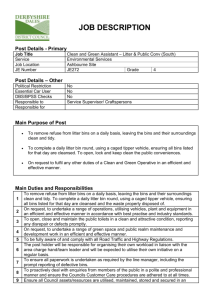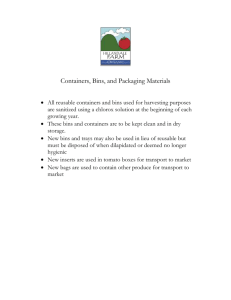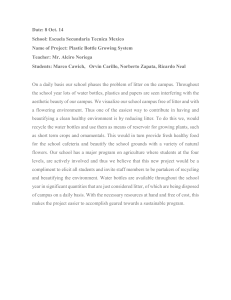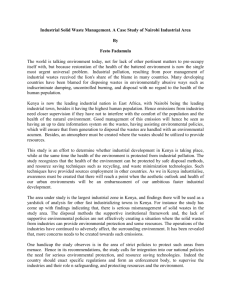web_paper - Centre for Ecological Sciences
advertisement
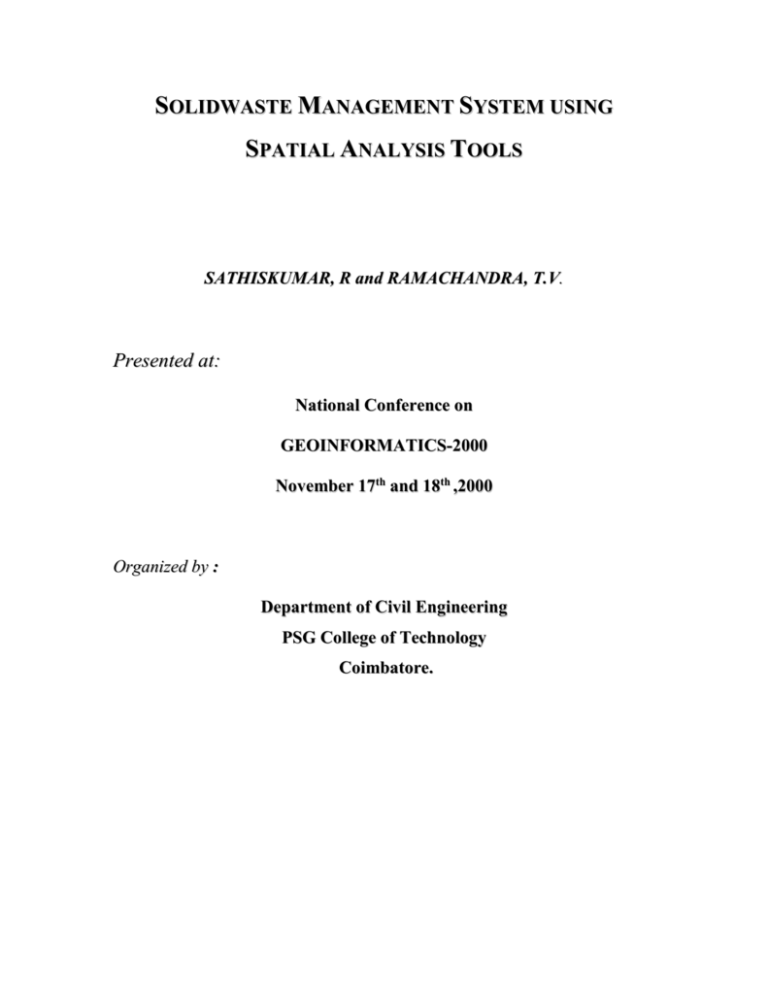
SOLIDWASTE MANAGEMENT SYSTEM USING SPATIAL ANALYSIS TOOLS SATHISKUMAR, R and RAMACHANDRA, T.V. Presented at: National Conference on GEOINFORMATICS-2000 November 17th and 18th ,2000 Organized by : Department of Civil Engineering PSG College of Technology Coimbatore. SOLIDWASTE MANAGEMENT SYSTEM USING SPATIAL ANALYSIS TOOL SATHISKUMAR, R and RAMACHANDRA, T.V* Abstract: Urban society generates and rejects solid material regularly. Due to rapid increase in production and consumption, volumes of wastes generated have increased considerably. Improper management of these wastes led to public health hazards, environmental pollution, unaesthetic appearance, etc. Most parts of India are not efficient in handling wastes when compared to developed countries. In order to improve the present practice, an effort is made to arrive at optimal solid waste management strategy by incorporating spatial analysis tool (Geographic Information System). This study is being carried out at Indian Institute of Science (IISc) campus, Bangalore, India. IISc Campus sprawling over 180 hectares with interdisciplinary activities have (40departments, 400 faculty members, 800 supporting staff, 1500students and 450 residential houses) generate various kinds of wastes ranging from paper, plastic materials, garbage, etc to metal, glass, construction debris, hazardous wastes. Quantification of various wastes from different sector through field investigations covering collection mechanism, primary constituents, rates of generation were done. Apart from this litter generated in vegetative and other areas has been quantified through landuse analysis. Optimal management strategy is proposed with these attribute information and various layers of spatial information i.e., road network, distribution of bins, type of bins, land use, topography and drainage network. * Corresponding Author Dr. T.V.Ramachandra, Energy and Wetlands Research Group, Centre for Ecological Sciences, Indian Institute of Science Bangalore 560 012, India E-mail: cestvr@ces.iisc.ernet.in Cestvr@hamsadvani.serc.iisc.ernet.in Energy@ces.iisc.ernet.in Fax: 91-080-3601428 / 3600085 / 3600683 [CES-TVR] Tel: 91-080-3600985 / 309 2506 2 SOLIDWASTE MANAGEMENT SYSTEM USING SPATIAL ANALYSIS TOOL Introduction A material becomes waste when the specific user of that material ceases to make use of it. Solid wastes are any non-liquid wastes that arise from human and animal activities that are normally solid and that are discarded as useless or unwanted. The quantities of solid waste generated in developing countries are increasing rapidly and may double (UNCHS, 1994) by the end of the decade due to burgeoning population growth, industrialization and unplanned economic growth. Most of the solid wastes produced in the cities remain uncollected and are dumped on vacant lands or into sewers and rivers. And those, which are collected, are often disposed off in open dumping grounds in an unacceptable manner, which stimulates numerous discomforts to the communities. For these reasons, optimal solid waste management has attracted considerable attention worldwide and numerous actions to promote sustainable human development focusing on environmentally sound management. The integrated approach to solid waste management also explores the remedial measures. Measures to be taken are (i) minimize the production the waste, (ii) maximize waste recycling and reuse, (iii) promote safe waste disposal and (iv) expand waste collection and disposal services. In this regard an attempt has been made to evolve proper management strategies with the help of GIS (Geographic Information System). This is being carried out at Indian Institute of Science (IISc) campus spread over an area of about 178 hectares. IISc with interdisciplinary activities of research and teaching and with housing facilities for staff and students replicates any city, from the point of generation and management of solid wastes. In view of these aspects the strategies evolved for IISc campus could easily be implemented in any urban areas in any developing countries. Objectives To explore the present management system in the campus To impart optimal solidwaste management system with in the campus Integrating spatial analysis tool to arrive at the best management strategy Study area IISc (Indian institute of science) campus with a spatial spread of 178 hectares lies within 13.010550 to 13.020830 latitude and 77.559440 to 77.573880 longitude. The present study is taken up to explore the present waste handling practices within the IISc campus having various interdisciplinary activities (40departments, 400 faculty members, 800 supporting staff, 1500 students and 450 residential houses) resembles a typical urban habitat. Wastes are due to activities arising from various sectors like residential, commercial, educational, and litter from open and vegetative area. The nature of the waste generated within campus comprises of, 3 Domestic wastes (food leftovers,vegetable peels,plastics,house sweepings,clothes , ash etc) Waste from educational, administrative and commercial buildings (paper,plastics,glasses, package materials which includes cardboard boxes, polystyrene, High Density polyethylene, etc) Hazardous wastes from laboratories, health Centre (Radio active chemicals, hazardous chemicals, infectious wastes etc) Waste from road cleansing and building debris (litter, dust, construction demolition wastes, etc) Waste from vegetative area (litter, garden trimmings, tree cuttings, etc) Methodology Collectoral data Integrating spatial analysis tool with management issues is a vital part of this study, Geographical Information System (GIS) software Mapinfo5.5 was used to create various vector layers from the Survey of India (SOI) toposheets of scale 1:1000. Digitized vector layers include Boundary Road network Buildings distribution (built up area) Distribution of all bins- spatial map of active bins Present dumping sites Land use and land cover map based on field data and remote sensing data Map showing litter study plots (used to quantify litter production) Contours, etc. Waste disposal at IISc campus: Types of bins and distribution Waste bins of various types are distributed over the campus in different locations to ensure waste is not dumped at roadside. Different types of waste bins namely cylindrical concrete bins (CON), small wooden bins (SB), cubic concrete bins (CUB), masonry hut bins (HUT) and stone bins (STB). Hut bins are constructed at key locations where quantity of waste expected is quiet high. Daily collection at hut bins constitutes about 20% of total solid waste in the campus. Different type and number of bins at IISc campus are listed in Table 1. 4 Table 1: Different types of waste bins at IISc campus Bintype concrete small green hut cubic stone others open dumping No 136 99 12 5 5 2 11 Small bins are provided to collect frequently generated wastes such as cigarette covers, envelopes etc. and are placed at strategic positions. Concrete bins, stone bins and cubic bins are provided at places, where waste is expected regularly. Apart from this, at various locations wastes open dumping on ground. In some localities such as duplex, E-Type, DType and Tunga residential staff quarters door to door collection is being attempted recently. Collection charges per household per month are Rs.15. Regular street sweeping and roadside garden trimmings are done and wastes are dumped in bins and sometimes in drainage also. Total quantity and Volume of waste per day In order to quantify wastes collected at each bin both visual (volume estimation) and weighing experiment were carried out. In the visual experiment, daily variation of volume of dustbin and approximate percentage of constituents were noted. Initially this was done for seven days covering all types of bins spread over the campus. The quantum of wastes collected at green bins was very less, hence further investigations were carried out in 128 bins (excluding green bins) for 15 days. This is repeated thrice in order to take in to account daily, weekly and seasonal variation. Visual volumes observed per bin are later converted in to equivalent weights taking in to consideration the density of materials (composition of wastes - paper, plastic, etc.). In order to verify the reliability of visual experiments (to quantify wastes), mass of constituent solid wastes were computed by actual measurements (using a balance of 100kg and sensitivity of 0.5 kg.) for 5 days in selected sample bins (25 bins spread all over the campus covering all communities and all activities). Sample bins were selected taking in to account the constituents and frequency of wastes generated in bins. Since there was a lot of variation in the visual and corresponding weighing experiments, this experiment was repeated again and was monitored for 15 days. In sample bins both visual and weighing experiments were carried out. This enabled in arriving at the relationship among the variables (for each constituent) got from visual and weighing experiments. Based on correlation coefficient and standard error the best relationship was chosen. This relationship was used to quantify the wastes of all bins in the campus (bins monitored visually, by considering volume of wastes). 5 Building spatial data base The spatial information of base layers (boundary, road network, distribution of buildings and dustbins) are generated using SOI maps of scale 1:1000 and field data collection. The vector layers of boundary, road network, buildings and dustbins were overlaid for further analyses. Land cover analyses is done by computing NDVI with IRS 1C multi-spectral data. Land use is done with the mapping of trees, buildings, etc. on the campus with the help of Global Positioning System (GPS). Vegetation analyses is carried out by dividing the campus in to one-hectare grids. Various vegetation indices [such as species density, tree density, diversity indices (Shannon-wiener and Simpson's indices), Evenness index] were calculated for each grid (Raja Raja Varma Murari, 1999). Overlaying these vegetative indices layers with equal weightage per layer, entire campus forms 15 zones. These zones correspond to the present land use pattern. Distribution of bins in each zone and present collection routes was mapped. Zones map and corresponding attribute data related to bins (such as total quantity and type of solid waste generated per day), a thematic map was created to get an overall idea of zones and its contribution in the total solid wastes generated at IISc campus. With these spatial and attribute database the feasibility options of solid waste management and aspects of recycling were explored. Estimating total quantity of litter Litter quantity for entire campus is estimated through sample plots of 1 sq.m. chosen randomly (stratified random sampling) covering all vegetative area of IISc campus. These sample plots were monitored daily for seven days. Litter quantified in these study plots was extrapolated for entire vegetative area based on tree and species density. Results and discussion The results obtained from first three cycles of experiments shows considerable variation between visual and weighing experiments. Consistency was achieved in the fourth cycle experiment which coincided with the new academic year. Fourth cycle experiment results are listed in the Table 2. 6 Table 2: Zonewise different wastes zone no no of bins open dump Active bins 1 2 3 4 5 6 7 8 9 10 11 12 13 14 15 51 54 34 32 4 4 35 0 0 0 8 19 5 5 8 259 1 5 0 0 1 0 2 1 1 0 0 0 0 0 0 11 23 31 14 11 2 2 22 0 0 0 4 1 5 4 4 123 weight generated per day in kg Paper plastic leaf dw total 47.46* 20.25* 31.48 9.672 108.9 35.29* 20.68* 108.9* 120.5* 285.4* 31.47* 10.64* 18.2 26.79 87.1 18.81 7.423 7.154 7.277 40.39 1.555 1.167 1.037 10.51 14.27 1.539 0.974 8.36 7.898 18.77 17.28* 18.63* 105.5* 141.1* 282.1* 0 0 0 0 0 0 0 0 0 0 0 0 0 0 0 6.53 3.102 18.84 2.779 31.25 0.879 0.504 1.293 3.116 5.793 4.013 3.007 9.722 18.41 35.16 1.32 0.792 1.6 5.699 9.413 3.49 2.17 5.302 10.64 21.61 170 89 317 364 940 considerable quantity of recyclable matter and fermentable organic matter Spatial information output Fig 1: Boundary layer of IISc Fig 2: Roadnetwork of IISc campus Fig 3: IISc Building distribution Fig 4: Spatial distribution of dustbins Fig 5: Road network, Dustbins and Buildings Fig 6: Locations where collection vehicles collect the waste Fig7: Map of tree density present per hectare Fig 8: Zones of IISc campus based on landuse pattern with spatial spread of Buildings Fig 9: Thematic map with all zones and proportion of waste generated. Fig 10: Map of litter study plots sprawling over campus Fig 11: optimal route for collection vehicle Analysis of results shows that zones 1,2 and 3 which include academic, administrative and hostel buildings contribute considerable quantity of recyclable materials like paper, paper envelops, and plastics (polyethylene 90%) which have good market value, if they are properly segregated from the waste stream. Separate dustbins can be provided to sort out recyclable material at source itself in these zones, thereby source reduction and also recycling can be accomplished. Considering the zone 2 and 7, which include residential, hostel and messes where fermentable matter quantity (80% of total waste) is quiet high, which can be reused to produce compost and biogas. Since those zones composes of residential quarters, hostels and mess, the door to door collection would be effective to segregate organic 7 wastes. Door to door segregated wastes collection, which is already in practice in a part of the residential area, could be extended to other parts. ASTRA's biomass plug flow fermenter technology (biogas plant) would be a viable alternative to utilize the available domestic waste and biomass. This system can handle 800kg of garbage per day, and has the payback period of 3 years and produces the enriched fertilizer after digestion (Dr.P.Rajbapaiah, 1995). Biogas generated could be supplied to low income households (such as helpers, who use fuelwood and kerosene). Litter monitored in 1m*1m randomly selected study plots, The average value is computed for each study plot which is extrapolated to entire IISc campus based on tree and species density. For this extrapolation tree density per hectare was computed and from the primary data of study plot, litter generated and number of trees in the study plot litter quantity per tree density was computed. The litter quantity was done for one-hectare study plot. Results are shown in Table 3. The leaf litter quantification was also done taking into account removal moisture content and woody branches. Table 3 Litter quantification Density No of Trees category per hec 1 2 3 4 5 6 7 8 362 to 622 252 to 362 176 to 252 134 to 176 102 to 134 78 to 102 46 to 78 1 to 46 no of Grids of size(1hec) 12 13 28 31 29 30 29 8 180 Ave.litter Quantity in gm/ m2/day 5.35 3.57 6.91 2.97 3.57 11.14 5.39 10.71 Total quantity category wise in kg/year 234330 169396.5 706202 336055.5 377884.5 1219830 570531.5 312732 3926962 Total quantity of litter produced for the total area =3926 t/year Total quantity of litter produced after removing moisture =1178 t/day Totals quantify of litter produced after removing woody litter =1001 t/year Total quantity produced per day per 180hec =2.74 t/day in the campus Total quantity produced per hectare per day =15.24 kg/hec/day or 5.546 t/ha/Yr Current practice of collection, vehicle collects wastes generated in the campus at a frequency varying from 1 to 3 days. It is necessary to arrive at better collection strategies for better utilization of waste materials generated at IISc campus. In this regard a transfer station is proposed to handle the waste collected from the other zones before final disposal. This station enhances further separation of bioresource and recycling products and reduces the volume of waste goes to final disposal. Regarding the hazardous waste (which including biological waste, hazardous chemicals and radioactive wastes) handling, the present practice for disposal is quiet satisfactory (personal discussion with Dr.Kondaiah) according to BARC specifications. But in future, when the waste dumping yard gets filled, it is necessary 8 to produce containers placed below ground level. Biological wastes arises from labs, healthcentre are in the form of cotton, broken glass utensils, contaminated clothes etc. care is given to these wastes and they are mixed with general waste stream. In order to avoid that specially designed dustbins should be placed in the sources to make aware of the public. As per KPCB (Karnataka Pollution Control Board) norms appropriate size of incinerator has to be designed to handle these wastes. As per present practice, which prevails in developed and developing countries for final disposal facilities such as incineration, sanitary landfill, gasification etc. have their own disadvantages and advantages and if final disposal rely on one disposal method, it won't be effective. Though different disposal techniques are available it is unfortunate that nowhere in India, the fully engineered disposal of solidwastes is implemented due to lack of strict laws. The current practice of waste disposal is nonengineered one (Masoor Ali, 1999) and campus waste is mixed with Bangalore City solid wastes, dumped (open dumping on ground) in corporation disposal site. The proposed (EPA,1989) integrated approach (i.e., combination of aspects like source reduction, recycling, incineration and landfilling) allows only inert materials to final disposal, which cause almost no environmental degradation Conclusions Quantification experiments shows the Total quantity generated in the campus is about 947 kgs per day, out of which percentage of recyclable matter (paper and plastics) contribution is 28% and fermentable compounds contribute 71%. These wastes could be converted to wealth by better usage through proper management. Implementation of recycling of papers and plastics, enhances the great weight and volume reduction of wastes, this facilitates further easier handling of solid waste. Utilization of available fermentable organic matter to produce biogas and compost becomes a source of income and creates employment opportunity and leads to greater reduction in volume and weight of waste to be disposed. Proposed solid waste management strategy of handling wastes if adopted, final disposal would have no negative impact on environment. This could be implemented elsewhere without much modification in India or in any developing country. Acknowledgements We thank Dr.Chankya for providing useful suggestions in carrying out quantification experiments .We thank Dr.Giridhar and Dr. Kondaiah for suggestions regarding quantification of hazardous wastes. This research is funded by Ministry of Environment and Forest, Government of India. 9 Reference 1. Dr.P.Rajabapaiah, waste management for IISc, 1995. Centre for the application of Science and Technology to Rural Area, IISc, Bangalore. 2. United Nations Centre for Human settlements (UNCHS), 1994. Promotion of Solid Waste Recycling and Reuse in the Developing Countries of Asia, Kenya:1.1 3. Raja Raja Varma Murari, 1999. Optimal Design of Rainwater Harvesting Structure using spatial and Temporal tools, government college of technology, Coimbatore:3839 4. Manoor Ali, Andrew Cotton and Ken Westlake, 1999. Solid waste disposal for LowIncome countries, Loughborough University, London :8 5. US Environmental Protection Agency, 1989. The Solid Waste Dilemma:An Agenda for action,Washington:17 10 Fig 1.Boundary of IISc 11 Fig2 ROAD NETWORK OF IISc 12 Fig:3 IISc BUILDING DISTRIBUTION 13 Fig4 DISTRIBUTION OF WASTE BINS 14 Fig 5 Roads, dustbins and buildings 15 Fig:6 Present collection points 16 Fig 7 IISc ONE HECTARE MAP SHOWING NO OF TREES PER HEC 17 Fig 8 IISc ZONES BASED ON LANDUSE PATTERN 18 Fig:9 Thematic Map showing Zonewise waste contribution 19 Fig10: Litter study plots all over campus 20 Fig 11: Optimal Route for waste collection vehicle 21


